Low-Load Limit in a Diesel-Ignited Gas Engine
Abstract
:1. Introduction
1.1. Motivation
1.2. Objective
1.3. Contributions
- A semi-physical mathematical model capable of reproducing the engine’s steady-state low-load performance and emissions in dual-fuel mode.
- The identification of low-load strategies that are optimal in terms of engine efficiency, HC emissions, or CO emissions.
1.4. Limitation of This Study
1.5. Structure
2. Low-Load Criteria
3. Experimental Setup
3.1. Engine Hardware
3.2. Engine Control
3.3. Independent Variables
4. Modeling
- The Diesel injection is chosen according to the Diesel-minimal approach [32].
- The exhaust-gas recirculation is of the type “high pressure” and “non-cooled”.
- The rotational speed of the engine is moderate, i.e., it does not exceed .
4.1. Model Structure
4.2. Model Components
4.2.1. Base Diesel
4.2.2. Diesel Injection
4.2.3. Gas Injection
4.2.4. Air Path
Fuel-to-Air Equivalence Ratio
Massflows
Gas Equivalence Ratio
Exhaust Temperature
Exhaust Pressure
Intake Conditions
4.2.5. Emission Levels of CO
4.2.6. HC Emissions
4.3. Model Parameters
5. Discussion
5.1. Low-Load Limits with Intake Throttling
5.1.1. Unburnt Hydrocarbon (HC) Limit
5.1.2. Limit of CO Reduction
5.2. Low-Load Limits with EGR
6. Results
6.1. Feasible Operation
6.2. Optimal Strategies
7. Conclusions
Outlook
Acknowledgments
Author Contributions
Conflicts of Interest
Abbreviations
| SOI | Start of Injection (Diesel) |
| DOI | Duration of Injection (Diesel) |
| HC | Unburnt Hydrocarbons (Emissions) |
| NOx | Nitrogen Oxides (Emissions) |
| EGR | Exhaust Gas Recirculation |
Appendix A. Derivations
Appendix A.1. Air Mass and Equivalence Ratio
Appendix A.2. Temperature of Undiluted Exhaust Gas
Appendix B. Independent Variables
Appendix B.1. Center of Combustion (COC)
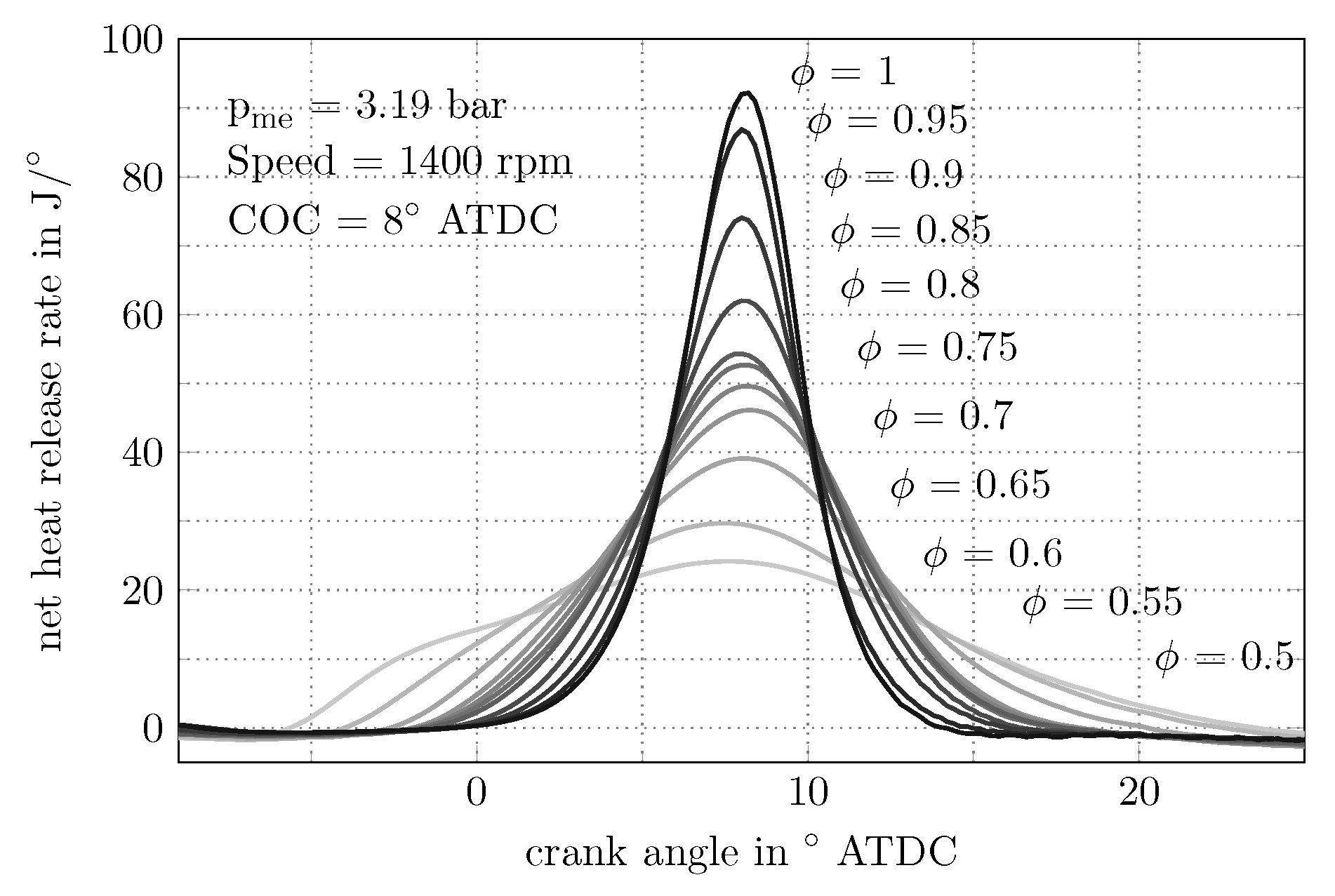
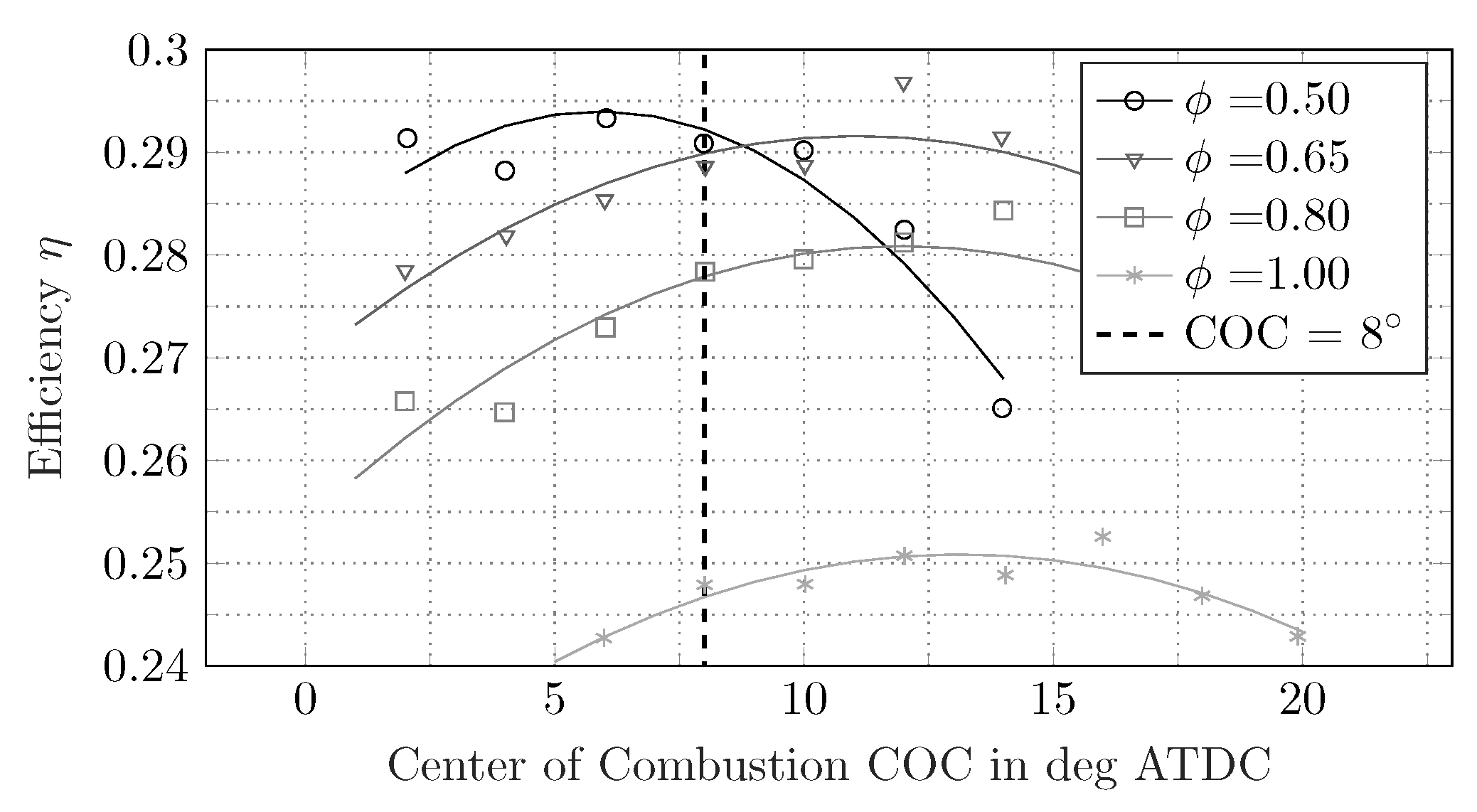
Appendix B.2. Start of Injection (SOI)
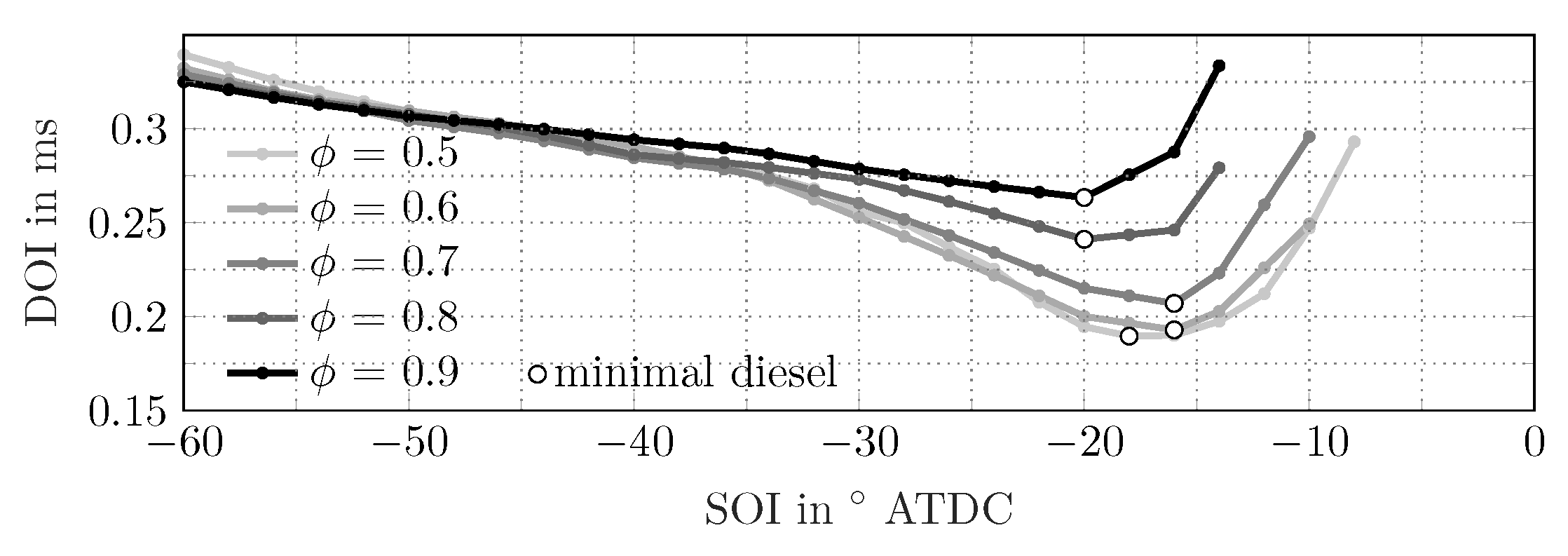
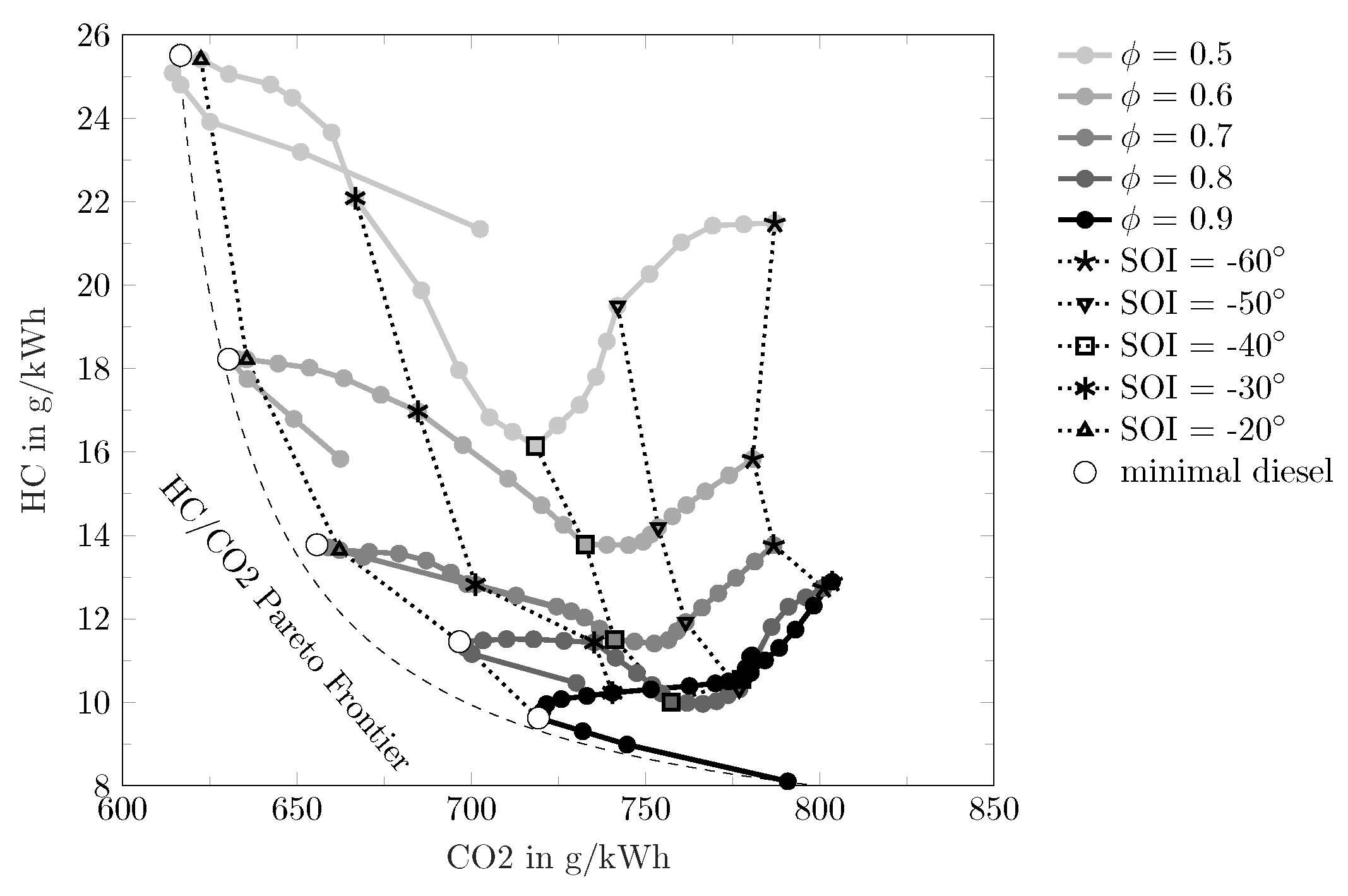
Appendix C. Estimating the Acceptable Engine-out Emissions of HC
| Parameter | Unit | Value |
|---|---|---|
| Vehicle mass | kg | 1929 |
| Aerodynamic drag coefficient | - | |
| Frontal area | ||
| Rolling friction coefficient | - | |
| Auxiliary power demand | W | 400 |
| Species | Euro VI | Euro VI | Reduction |
|---|---|---|---|
| HC | 90 mg/km | 0.67 g/kWh | 13.3 g/kWh |
Appendix D. Experimental Operating Points
| Engine Speed | Brake Mean | Equivalence | |
|---|---|---|---|
| Effective Pressure | Ratio (Steps ) | ||
| 1 | |||
| 2 | |||
| 3 | |||
| 4 | |||
| 5 | |||
| 6 | |||
Appendix E. Measurement Uncertainty
| Measured Variable | Uncertainty Estimate (Absolute Value) | Sensor Type | Manufacturer |
|---|---|---|---|
| CO | Nondispersive infrared sensor | Cambustion Ltd, Cambridge, UK | |
| HC | Flame ionization detector | Cambustion Ltd, Cambridge, UK | |
| Thermocouple | SAB Bröckskes GmbH & Co. KG, Viersen, DE | ||
| Nondispersive infrared sensors | Cambustion Ltd, Cambridge, UK | ||
| @ @ | Lambda sensor (LSU 4.9) | Robert Bosch GmbH, Stuttgart, DE | |
| Torque transducer | Vibrometer SA, Fribourg, CH |
References
- Karim, G. The Dual Fuel Engine of the Compression Ignition Type–Prospects, Problems and Solutions—A Review; SAE Technical Paper, No. 831073; SAE International: Warrendale, PA, USA, 1983. [Google Scholar]
- Badr, O.; Karim, G.; Liu, B. An examination of the flame spread limits in a dual fuel engine. Appl. Therm. Eng. 1999, 19, 1071–1080. [Google Scholar] [CrossRef]
- Eichmeier, J.; Wagner, U.; Spicher, U. Controlling gasoline low temperature combustion by diesel micro pilot injection. J. Eng. Gas Turbines Power 2012, 134, 072802. [Google Scholar] [CrossRef]
- Ishiyama, T.; Kang, J.; Ozawa, Y.; Sako, T. Improvement of Performance and Reduction of Exhaust Emissions By Pilot-Fuel-Injection Control in a Lean-Burning Natural-Gas Dual-Fuel Engine; SAE Technical Paper, No. 2011-01-1963; SAE International: Warrendale, PA, USA, 2011. [Google Scholar]
- Ogawa, H.; Zhao, P.; Kato, T.; Shibata, G. Improvement of Combustion and Emissions in a Dual Fuel Compression Ignition Engine with Natural Gas as the Main Fuel; SAE Technical Paper, No. 2015-01-0863; SAE International: Warrendale, PA, USA, 2015. [Google Scholar]
- Königsson, F.; Stalhammar, P.; Angstrom, H.E. Characterization and Potential of Dual Fuel Combustion in a Modern Diesel Engine; SAE Technical Paper, No. 2011-01-2223; SAE International: Warrendale, PA, USA, 2011. [Google Scholar]
- Dronniou, N.; Kashdan, J.; Lecointe, B.; Sauve, K.; Soleri, D. Optical Investigation of Dual-fuel CNG/Diesel Combustion Strategies to Reduce CO2 Emissions. SAE Int. J. Engines 2014, 7, 873–887. [Google Scholar] [CrossRef]
- Li, M.; Zhang, Q.; Li, G. Emission Characteristics of a Natural Gas Engine Operating in Lean-Burn and Stoichiometric Modes. J. Energy Eng. 2015, 04015039. [Google Scholar] [CrossRef]
- Nieman, D.E.; Dempsey, A.B.; Reitz, R.D. Heavy-duty RCCI operation using natural gas and diesel. SAE Int. J. Engines 2012, 5, 270–285. [Google Scholar] [CrossRef]
- Splitter, D.; Hanson, R.; Kokjohn, S.; Reitz, R.D. Reactivity Controlled Compression Ignition (RCCI) Heavy-Duty Engine Operation at Mid-and High-Loads with Conventional and Alternative Fuels; SAE Technical Paper, No. 2011-01-0363; SAE International: Warrendale, PA, USA, 2011. [Google Scholar]
- Kokjohn, S.; Hanson, R.; Splitter, D.; Reitz, R. Fuel reactivity controlled compression ignition (RCCI): A pathway to controlled high-efficiency clean combustion. Int. J. Engine Res. 2011, 12, 209–226. [Google Scholar] [CrossRef]
- Walker, N.R.; Chuahy, F.D.; Reitz, R.D. Comparison of Diesel Pilot Ignition (DPI) and Reactivity Controlled Compression Ignition (RCCI) in a Heavy-Duty Engine. In ASME 2015 Internal Combustion Engine Division Fall Technical Conference; American Society of Mechanical Engineers: New York, NY, USA, 2015; pp. V001T03A016:1–V001T03A016:13. [Google Scholar]
- Zurbriggen, F.J. Combustion Control of a Natural Gas-Diesel Engine-Feedback Control and Adaptation. Ph.D. Thesis, Nr. 23022. ETH Zürich, Zürich, Schweiz, 2016. [Google Scholar]
- Ott, T.; Onder, C.; Guzzella, L. Hybrid-electric vehicle with natural gas-diesel engine. Energies 2013, 6, 3571–3592. [Google Scholar] [CrossRef]
- Ott, T. Hybrid-Electric Vehicle with Natural Gas-Diesel Engine. Ph.D. Thesis, Nr. 21678. ETH Zürich, Zürich, Schweiz, 2013. [Google Scholar]
- Serrano, D.; Bertrand, L. Exploring the Potential of Dual Fuel Diesel-CNG Combustion for Passenger Car Engine. In Proceedings of the FISITA 2012 World Automotive Congress, Beijing, China, 27–30 November 2012; Springer: Berlin, Germany, 2013; pp. 139–153. [Google Scholar]
- Serrano, D.; Obiols, J.; Lecointe, B. Optimization of Dual Fuel Diesel-Methane Operation on a Production Passenger Car Engine—Thermodynamic Analysis; SAE Technical Paper, No. 2013-01-2505; SAE International: Warrendale, PA, USA, 2013. [Google Scholar]
- Selim, M.Y. Effect of exhaust gas recirculation on some combustion characteristics of dual fuel engine. Energy Convers. Manag. 2003, 44, 707–721. [Google Scholar] [CrossRef]
- Dishy, A.; You, T.; Iwashiro, Y.; Nakayama, S.; Kihara, R.; Saito, T. Controlling Combustion and Exhaust Emissions in a Direct-Injection Diesel Engine Dual-Fueled With Natural Gas; SAE Technical Paper, No. 952436; SAE International: Warrendale, PA, USA, 1995. [Google Scholar]
- Taniguchi, S.; Masubuchi, M.; Kitano, K.; Mogi, K. Feasibility Study of Exhaust Emissions in a Natural Gas Diesel Dual Fuel (DDF) Engine; SAE Technical Paper, No. 2012-01-1649; SAE International: Warrendale, PA, USA, 2012. [Google Scholar]
- Sprenger, F.; Fasching, P.; Kammerstaetter, S. Experimental Investigation of CNG-Diesel Combustion Processes with External and Internal Mixture Formation for Passenger Car Application. In Proceedings of the Conference on the Working Process of the Internal Combustion Engine, Graz, Austria, 24–25 September 2015. [Google Scholar]
- Fasching, P.; Sprenger, F.; Eichlseder, H. Experimental Optimization of a Small Bore Natural Gas-Diesel Dual Fuel Engine with Direct Fuel Injection. SAE Int. J. Engines 2016, 9, 1072–1086. [Google Scholar] [CrossRef]
- Usmen, R.K.; Subramanian, S.; McCabe, R.W.; Kudla, R.J. Design Considerations for Natural Gas Vehicle Catalytic Converters; SAE Technical Paper, No. 933036; SAE International: Warrendale, PA, USA, 1993. [Google Scholar]
- Andersson, B.; Cruise, N.; Lunden, M.; Hansson, M. Methane and Nitric Oxide Conversion Over a Catalyst Dedicated for Natural Gas Vehicles; SAE Technical Paper, No. 2000-01-2928; SAE International: Warrendale, PA, USA, 2000. [Google Scholar]
- Abd-Alla, G.; Soliman, H.; Badr, O.; Abd-Rabbo, M. Effects of diluent admissions and intake air temperature in exhaust gas recirculation on the emissions of an indirect injection dual fuel engine. Energy Convers. Manag. 2001, 42, 1033–1045. [Google Scholar] [CrossRef]
- Besch, M.C.; Israel, J.; Thiruvengadam, A.; Kappanna, H.; Carder, D. Emissions Characterization from Different Technology Heavy-Duty Engines Retrofitted for CNG/Diesel Dual-Fuel Operation. SAE Int. J. Engines 2015, 8, 1342–1358. [Google Scholar] [CrossRef]
- Arrègle, J.; López, J.J.; Guardiola, C.; Monin, C. On-board NOx prediction in diesel engines: A physical approach. In Automotive Model Predictive Control; Springer: Berlin, Germany, 2010; pp. 25–36. [Google Scholar]
- Woschni, G.; Zeilinger, K. 2-Zonen Rechenmodell zur Vorausrechnung der NO-Emission von Dieselmotoren. MTZ Motortechnische Z. 1998, 59, 770–775. [Google Scholar]
- Schilling, A.; Amstutz, A.; Onder, C.H.; Guzzella, L. A real-time model for the prediction of the NOx emissions in DI diesel engines. In Proceedings of the 2006 IEEE Computer Aided Control System Design, IEEE International Conference on Control Applications, IEEE International Symposium on Intelligent Control (CACSD-CCA-ISIC), Munich, Germany, 4–6 October 2006; pp. 4–6. [Google Scholar]
- Krijnsen, H.C.; van Kooten, W.E.; Calis, H.P.A.; Verbeek, R.P.; Bleek, C.M. Prediction of NOx emissions from a transiently operating diesel engine using an artificial neural network. Chem. Eng. Technol. 1999, 22, 601–607. [Google Scholar] [CrossRef]
- Guzzella, L.; Sciarretta, A. Vehicle Propulsion Systems, 3rd ed.; Springer: Berlin, Germany, 2013. [Google Scholar]
- Zurbriggen, F.; Hutter, R.; Onder, C. Diesel-Minimal Combustion Control of a Natural Gas-Diesel Engine. Energies 2016, 9, 58. [Google Scholar] [CrossRef]
- Guzzella, L.; Onder, C. Introduction to Modeling and Control of Internal Combustion Engine Systems; Springer: Berlin, Germany, 2009. [Google Scholar]
- Müller, M. General Air Fuel Ratio and EGR Definitions and Their Calculation from Emissions; SAE Technical Paper, No. 2010-01-1285; SAE International: Warrendale, PA, USA, 2010. [Google Scholar]
- Moran, M.J.; Shapiro, H.N.; Boettner, D.D.; Bailey, M.B. Fundamentals of Engineering Thermodynamics; John Wiley & Sons: Hoboken, NJ, USA, 2010. [Google Scholar]
- Heywood, J.B. Internal Combustion Engine Fundamentals; McGraw-Hill: New York, NY, USA, 1988; Volume 930. [Google Scholar]
- Kusaka, J.; Okamoto, T.; Daisho, Y.; Kihara, R.; Saito, T. Combustion and exhaust gas emission characteristics of a diesel engine dual-fueled with natural gas. JSAE Rev. 2000, 21, 489–496. [Google Scholar] [CrossRef]
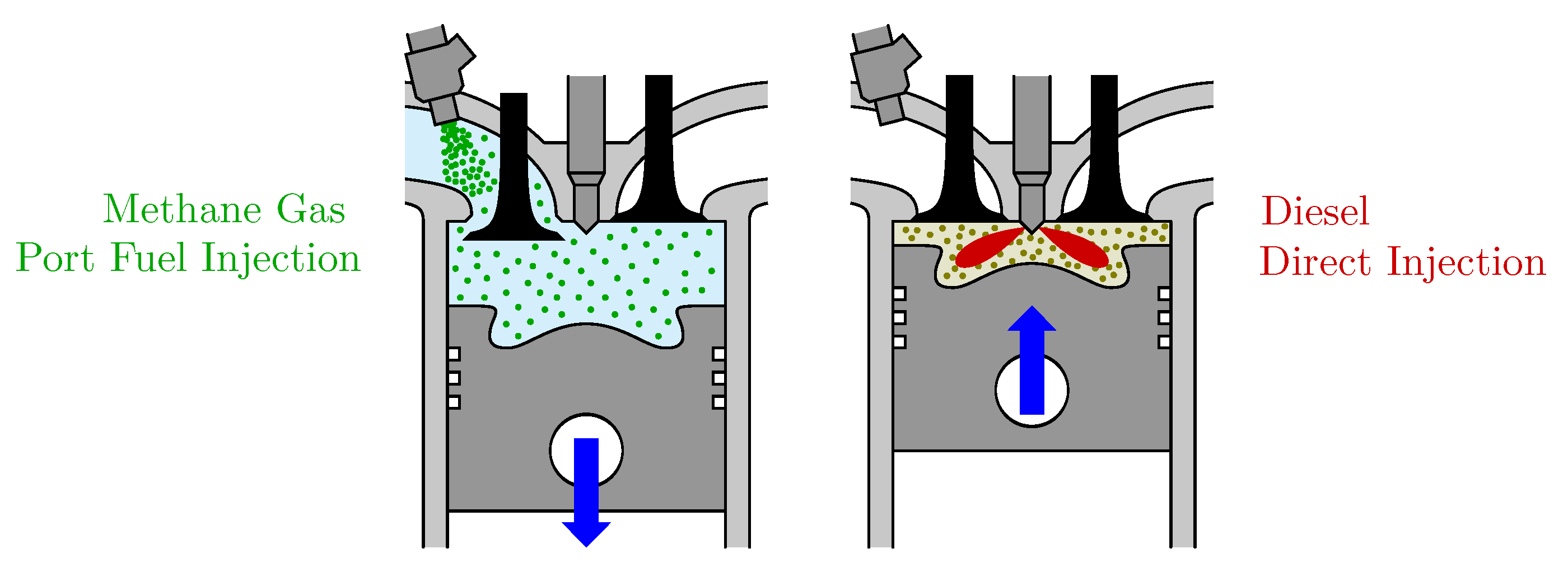
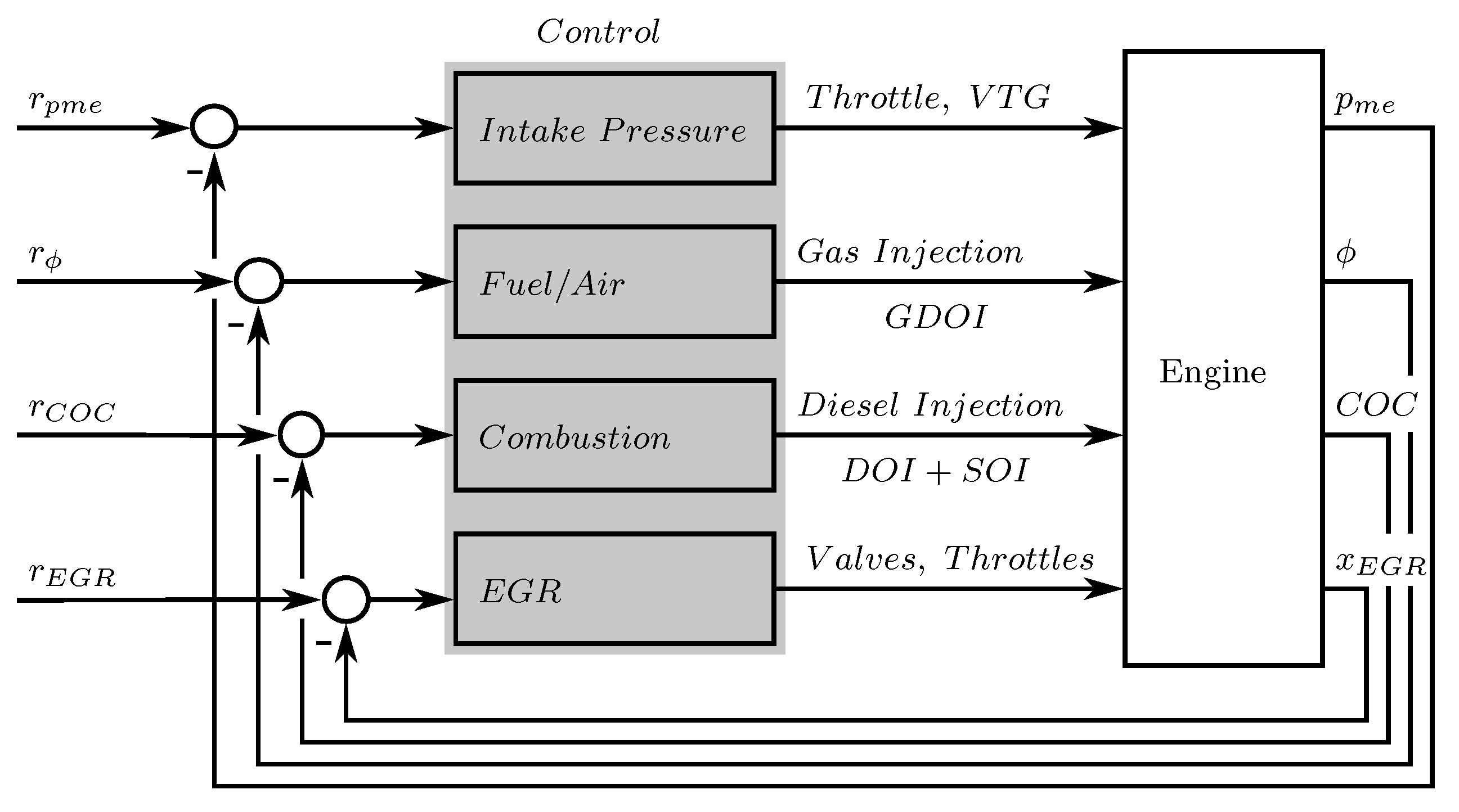
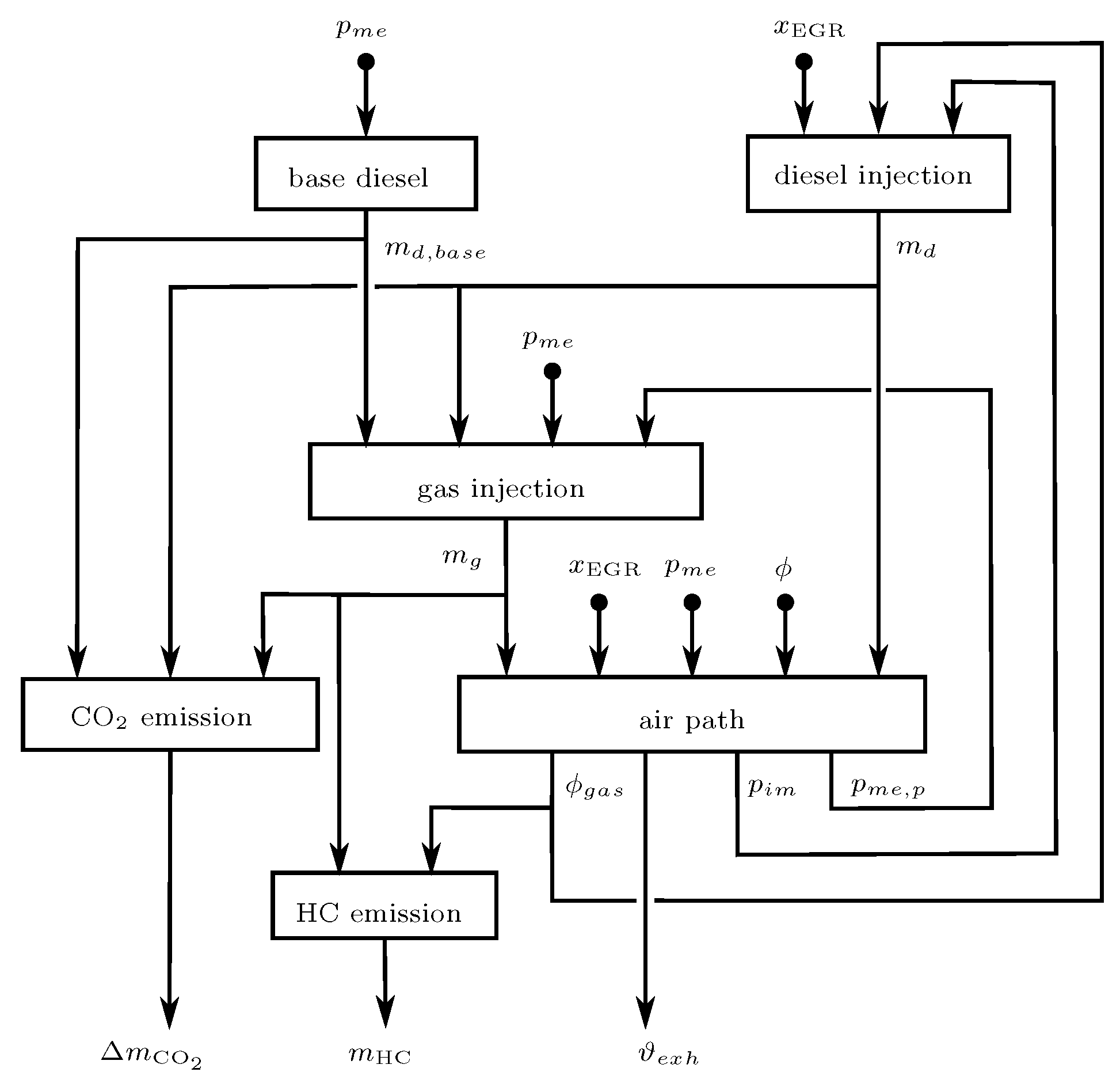



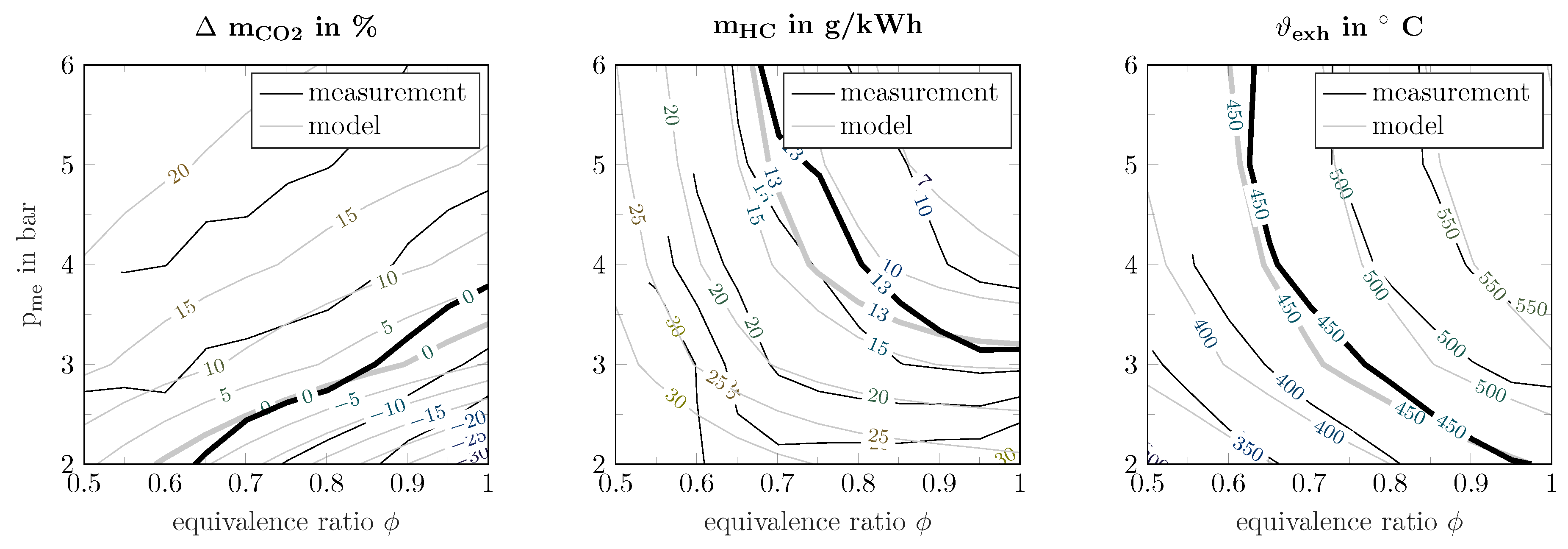
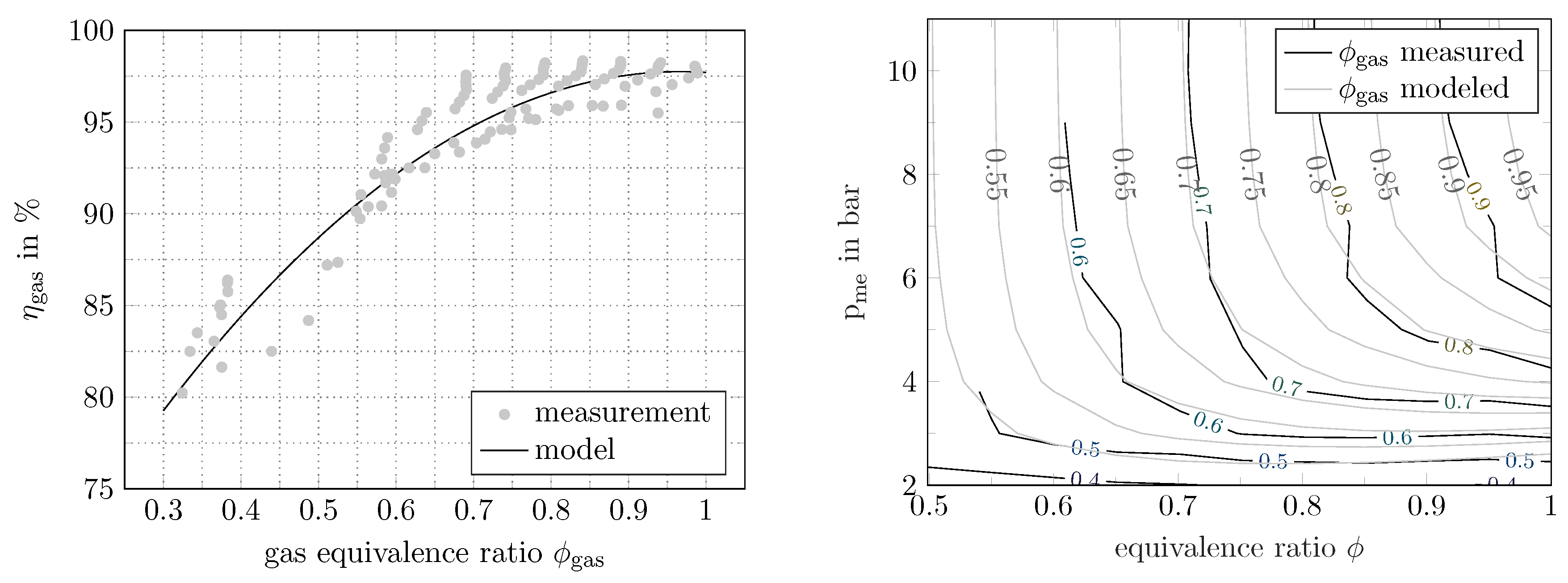
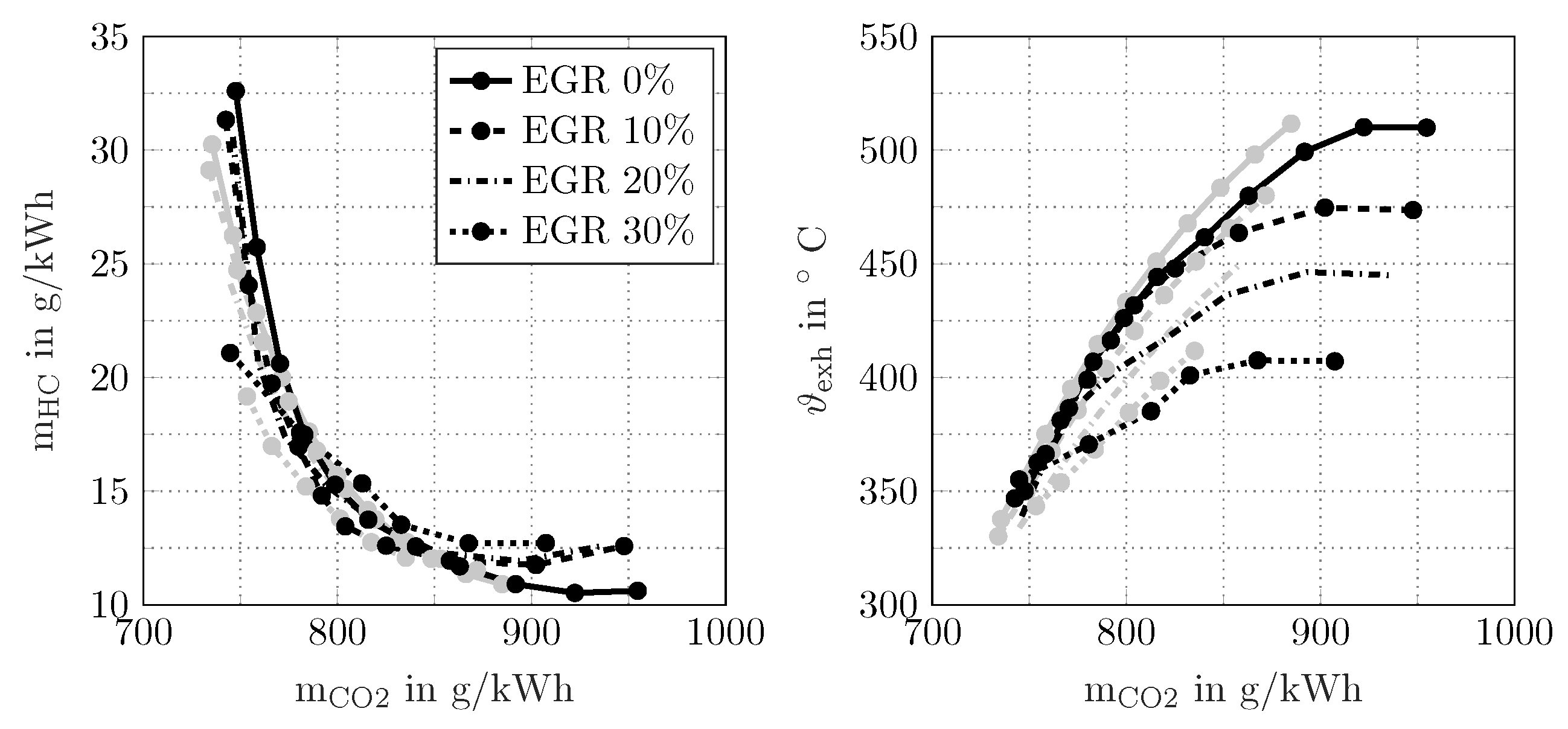

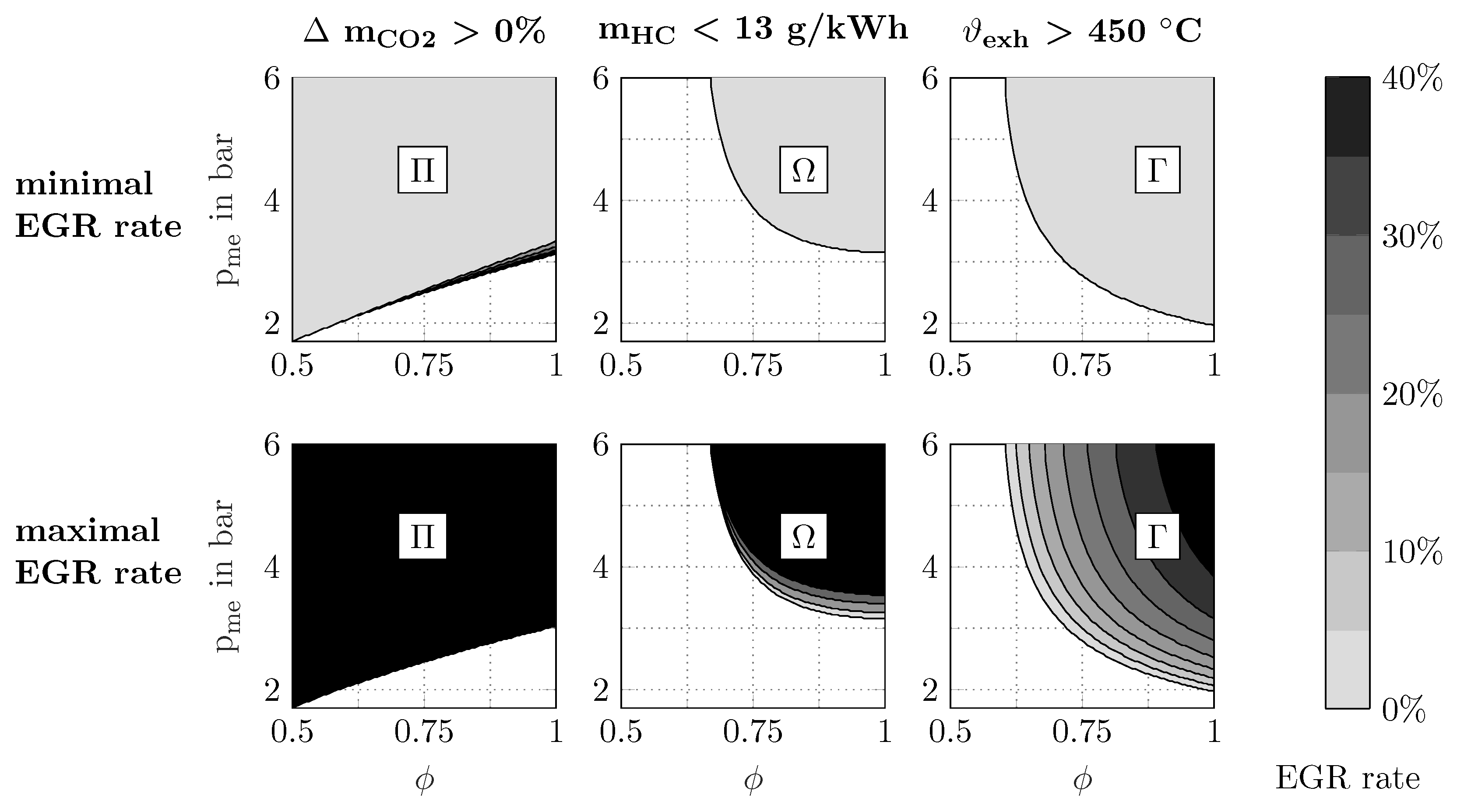

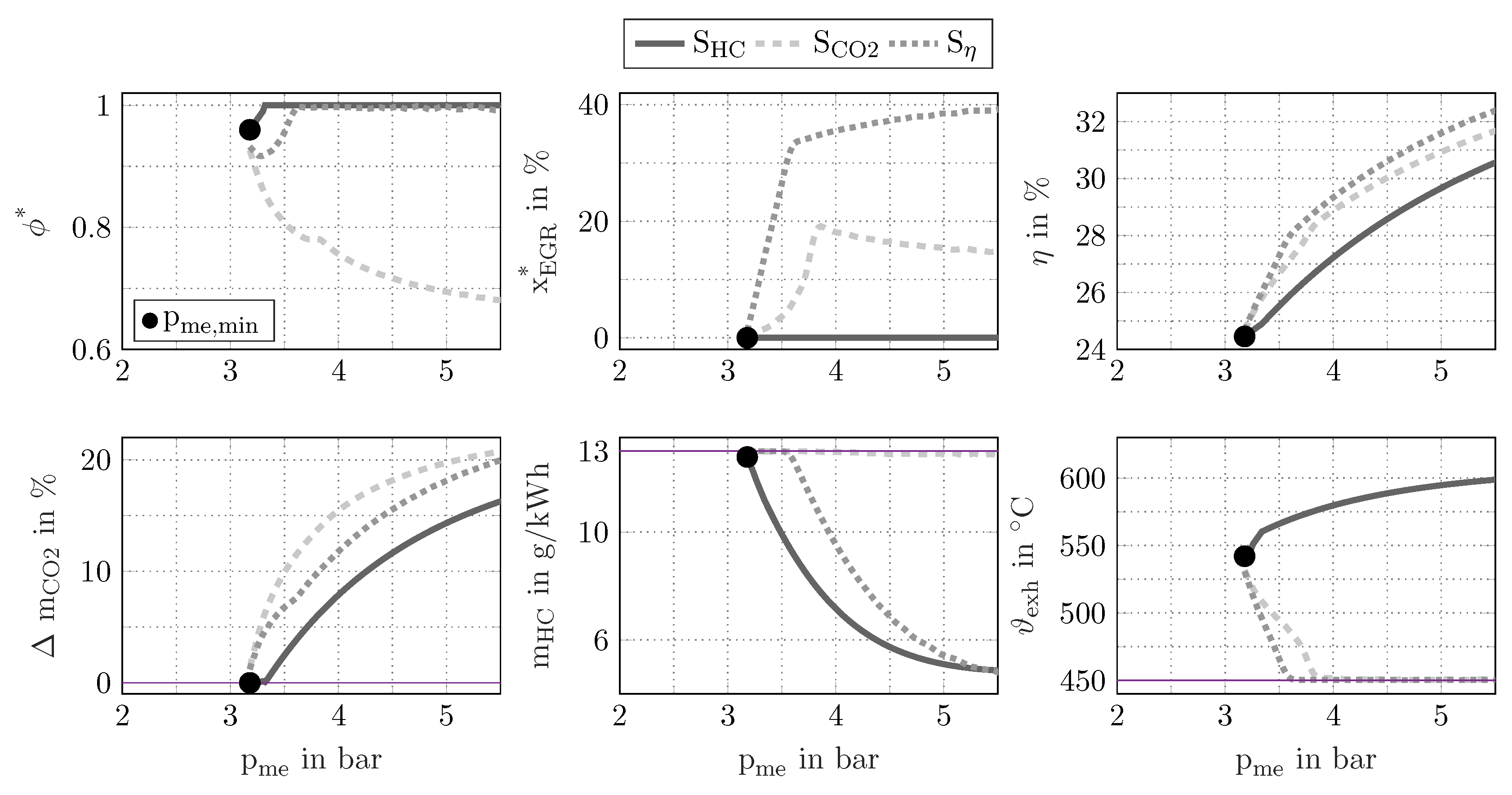
| Description | Symbol | Value |
|---|---|---|
| CO reduction | > | |
| HC engine-out emission | < | |
| Exhaust gas temperature | > |
| Description | Unit | Value |
|---|---|---|
| Displacement | 1986 | |
| Number of cylinders | - | 4 |
| Bore/Stroke | ||
| Compression ratio | - |
| Description | Symbol | Value |
|---|---|---|
| Brake mean effective pressure | DOF | |
| Equivalence ratio | DOF | |
| EGR ratio | DOF | |
| Center of combustion | constant | |
| Start of injection (Diesel) | Diesel-minimal |
| Symbol | Description |
|---|---|
| Brake mean effective pressure | |
| Fuel-to-air equivalence ratio | |
| Exhaust gas recirculation rate |
| Symbol | Description |
|---|---|
| CO reduction | |
| HC engine-out emission | |
| Exhaust gas temperature |
| Symbol | Description |
|---|---|
| Diesel mass | |
| Gas mass | |
| Diesel mass in the base engine | |
| Gas equivalence ratio | |
| Intake manifold pressure | |
| Pump mean effective pressure |
| Affine Function with | |||
|---|---|---|---|
| Approximation of 5th Order Polynomial Data Provided by [35]. | |||
| Diesel exhaust gas | |||
| Methane exhaust gas | |||
| Air | |||
| Description | Value | Unit | |
|---|---|---|---|
| Friction and gas exchange loss coefficient | |||
| e | Efficiency coefficient | % | |
| Displacement volume | 1968 | ||
| Compression ratio | - | ||
| Lower heating value Diesel | 43 | ||
| Lower heating value of gas | 50 | ||
| Stoichiometric air-to-fuel ratio of Diesel | 14 | ||
| Mean molar weight of exhaust gases | |||
| Mean molar weight of air | |||
| Oxygen concentration of air | 21 | % | |
| R | Universal gas constant | ||
| Heat transfer coefficient | |||
| Nominal intake temperature | 310 | K | |
| Stoichiometric air-to-fuel ratio of methane gas | |||
| CO coefficient of Diesel | |||
| CO coefficient of methane gas | |||
| Mean volumetric efficiency | 80 | % |
| Name | Goal | |
|---|---|---|
| minimize engine-out HC emissions | ||
| minimize CO emissions | ||
| maximize engine efficiency |
| Strategy | ||
|---|---|---|
| 1 | 0 | |
| <1 | >0 | |
| 1 | >0 |
© 2017 by the authors. Licensee MDPI, Basel, Switzerland. This article is an open access article distributed under the terms and conditions of the Creative Commons Attribution (CC BY) license (http://creativecommons.org/licenses/by/4.0/).
Share and Cite
Hutter, R.; Ritzmann, J.; Elbert, P.; Onder, C. Low-Load Limit in a Diesel-Ignited Gas Engine. Energies 2017, 10, 1450. https://doi.org/10.3390/en10101450
Hutter R, Ritzmann J, Elbert P, Onder C. Low-Load Limit in a Diesel-Ignited Gas Engine. Energies. 2017; 10(10):1450. https://doi.org/10.3390/en10101450
Chicago/Turabian StyleHutter, Richard, Johannes Ritzmann, Philipp Elbert, and Christopher Onder. 2017. "Low-Load Limit in a Diesel-Ignited Gas Engine" Energies 10, no. 10: 1450. https://doi.org/10.3390/en10101450





